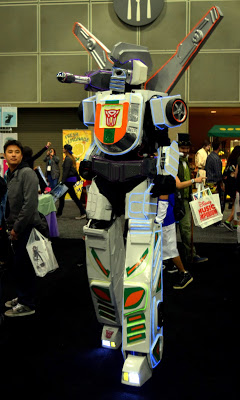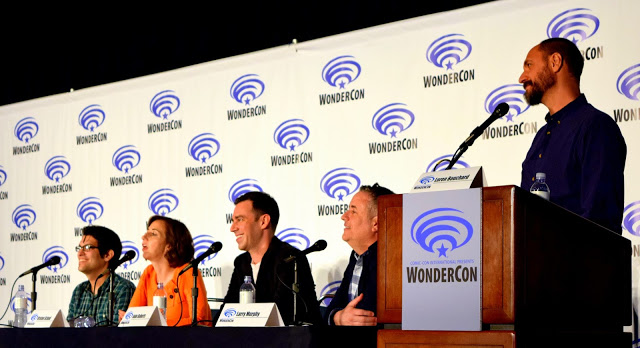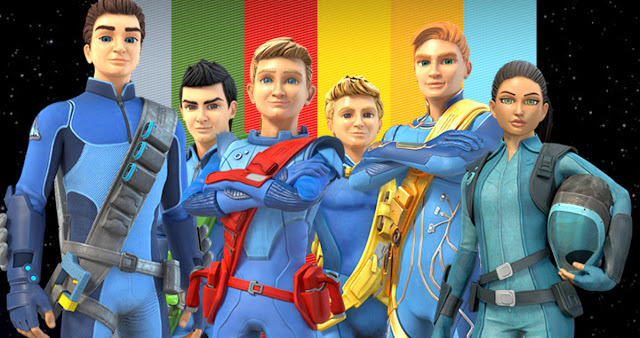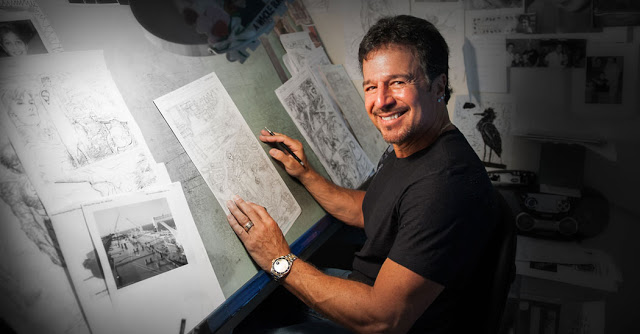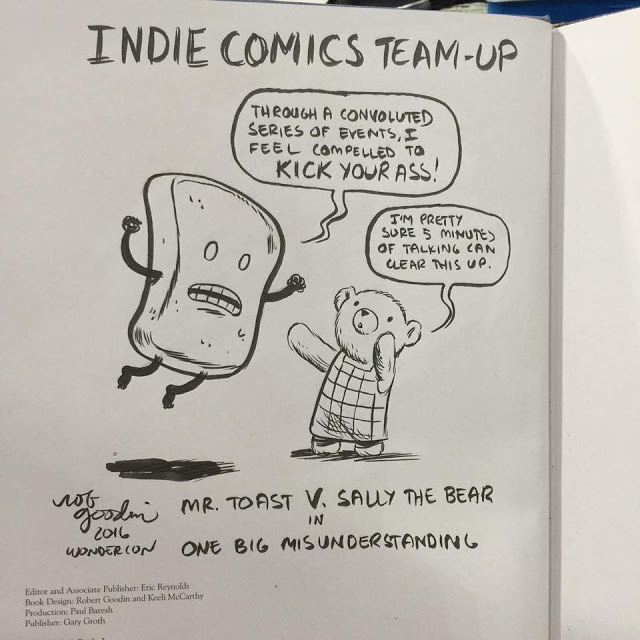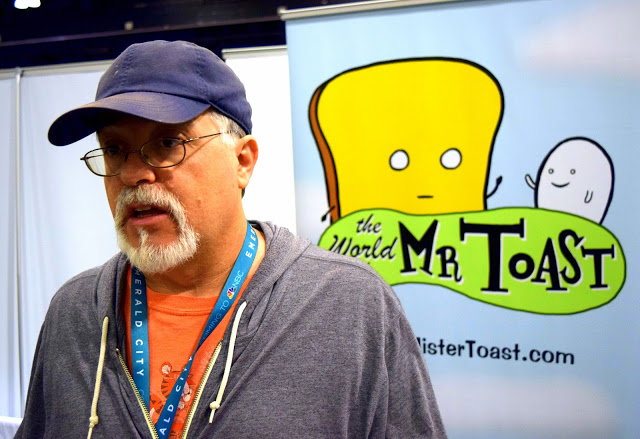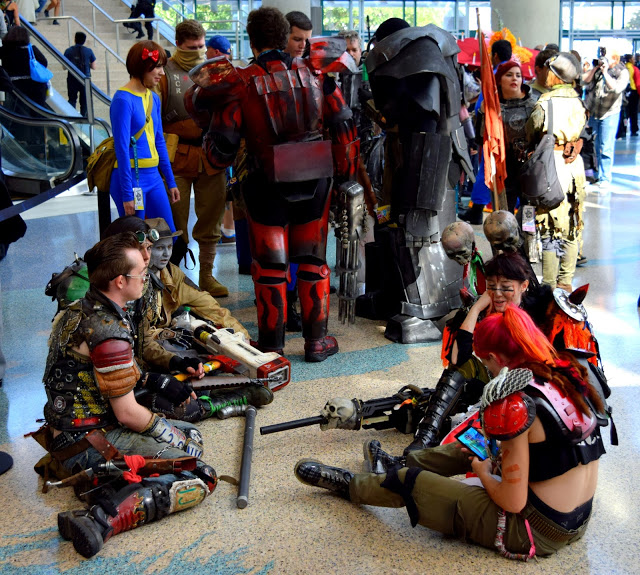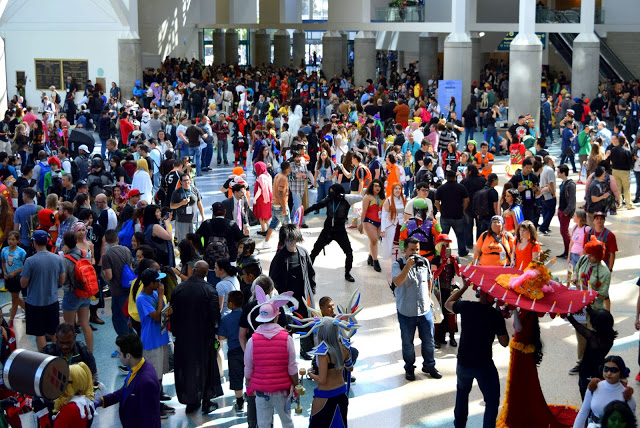 |
| Written by Lily and Generoso Fierro |
Much to our delight, the 2016 edition of WonderCon, which is run by the folks who give us San Diego Comic-Con, was moved to downtown Los Angeles for what turns out to be just a sabbatical away from its usual home in Anaheim as an experiment for the future.
Given our location, the Los Angeles Convention Center was just a 15 minute bus ride away, and on that bus ride, Generoso regaled Lily with stories of his earliest experiences going to such events, which set up the weekend as we were transported back to our teenage years the moment we arrived to WonderCon.
We had two events that, for each of us, would surely bring out our lost adolescent years. For Lily, it was the Bob’s Burgers panel, a chance to connect the voices of Louise, Tina, Linda, and Teddy to the faces of the actors who make their characters come alive.
For Generoso, it was the sneak peek of the reboot of the classic Gerry Anderson supermarionation series Thunderbirds, which has brought along the actor who voiced the original Parker, David Graham.
As with most comicbook related events, we first took to the exhibition floor with no exact agenda in the hope of finding new talent, since we are always on the hunt for something exciting in the indie comics realm.
Much to our surprise, the books we most enjoyed also brought out the child within us, with the exception of Robert Goodin’s The Spiritual Crisis of Carl Jung, which certainly is not a book for a budding adolescent but was one of the strongest works for an adult audience that we found over the weekend.
Though we found more than a couple of books that did not appeal to us, such as Ollie Masters, Ming Doyle, and Jordie Bellaire’s The Kitchen, none of the panels that we attended were remotely disappointing here.
So, before we get to the comicbook reviews, let’s talk about some of the panels that stood out for us.
Bob’s Burgers
First, let’s discuss that much anticipated Bob’s Burgers panel, which was moderated by one of the series’ creators, Loren Bouchard and featured Kristen Schaal (Louise), Dan Mintz (Tina), John Roberts (Linda), and (Teddy).
While Loren Bouchard’s presentation of many clips from the upcoming season, including possibly the most pathetic and heart-wrenching storyline for Teddy involving his ex-wife and a very sad boat, brought much excitement to us and the audience, the improv abilities of these actors made this one of the funniest panels that we have attended since the irresponsibly hysterical Titmouse panel at Comikaze last fall.
Here’s a hint for future attendees to a Bob’s Burgers panel: just as a parochial school nun will ask you, “Did you bring enough gum for everyone in the class?,” if you created handmade dolls for two of your favorite characters, it may be in your best interest to make dolls for everyone on the panel. Otherwise, you will feel the wrath of John Roberts, who went on a slightly psychotic, profanity laden tirade when Dan Mintz and Kristen Schaal were handed homemade versions of their animated selves: “You could just give me my Linda doll later. My dog would probably eat it…”
Past John Robert’s indignation, Loren Bouchard confirmed that an album, yes one released on vinyl, featuring all of the most ridiculous songs featured on the show will be released sometime before his death. In addition, everyone’s favorite overly promiscuous and safe sex adverse biker gang, the One-eyed Snakes, will return for an episode this coming season. Seeing the creators of Bob’s Burgers not only built excitement for the upcoming episodes of the show but also reinforced the talent of the people involved. If the creators can make you laugh, the show should too!
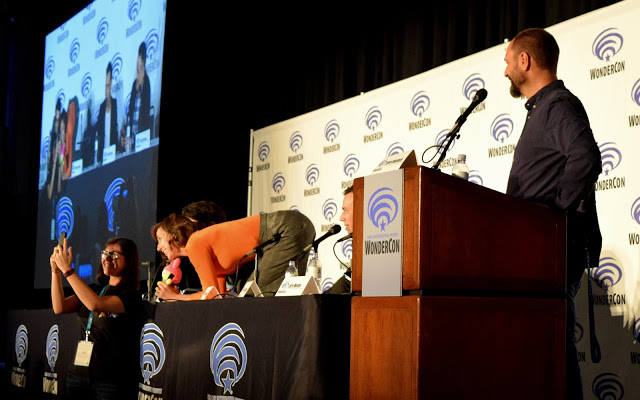 |
| Kristen Schaal loves her handmade doll! |
Thunderbirds Are Go!
It was indeed a lovely surprise to see David Graham from the original Thunderbirds sitting on the panel for the rebooted version, Thunderbirds are Go!, which is being produced by the folks at Amazon. Writer Rob Hoegee assured the audience from the onset that long gone are the cigarettes and martinis of the original Thunderbirds for this predominantly CGI animated series that is aimed at younger audiences than its predecessor. After a fairly short discussion and a few questions from the audience, we were given a sneak preview of episode one of the new show.
The vigilance of International Rescue to save lives is still present, but the James Bond era coolness is sadly long gone in favor of an overwhelming musical soundtrack and some fairly banal attempts at humor and relevance in modern time. There are, of course, a few scenes that utilize live action model sets in the spirit of the original program, which are quite impressive but sadly only represent of a small amount of the overall CGI animation, which is too slick for its own good.
We will say that the panel was not without merit, for the discussion between the actors was at times interesting in the way they embraced the nostalgia of Anderson’s most well known work.
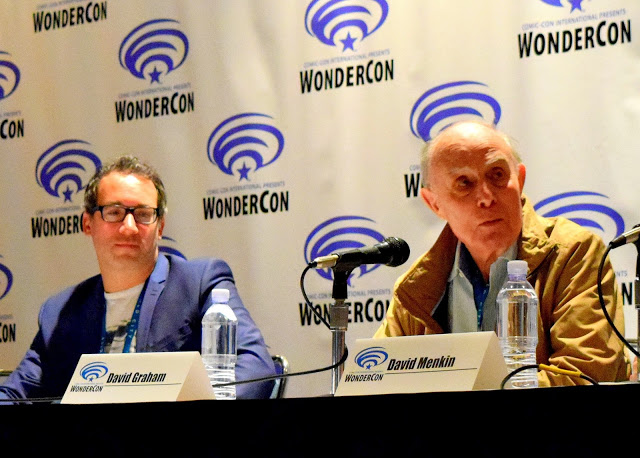 |
| The creators of Thunderbirds Are Go! |
Spotlight on John Romita Jr.
Of the other panels we enjoyed during our time at WonderCon, we very much appreciated the solo appearance of John Romita Jr., the artist whose body of work includes issues of Iron Man, The Amazing Spider-Man, Daredevil, The Eternals, and Kick-Ass.
Romita was in great spirits throughout his one hour conversation with the audience. A standout moment of that talk occurred when an audience member asked him which single issue is his best creative work, to which Romita Jr. replied, his work on issue #36 of Amazing Spider-Man, which served as a memorial to the victims of the September 11th attacks; though the artist was very proud of that work, he also immediately stated that it is not necessarily an issue to be celebrated because it is addressing a very dark topic and day in American contemporary history.
There were also the inevitable comparison questions to his father, John Romita, which Romita Jr. handled with humble grace, discussing how the work of his father and that of fine artists inspires him and pushes him to improve because they remind him of the mesmerizing power of art, which he feels he has only minimally achieved in comparison. Romita Jr. was never less than generous with his answers and considering the vast amount of impeccable work he has done, he was also never less than modest and giving.
The Asian American Superhero
Hearkening back to Comikaze 2015 for a moment, where we saw a panel featuring Stan Lee, Marc Silvestri, Todd McFarlane, and Jim Lee, some of the greatest names in the history of the comicbook medium, we were beyond thrilled to see on the schedule a panel that also had Jim Lee as a member but this time discussing a topic far different than that of the comicbook legends, “The Asian American Superhero.”
We have attended several panels addressing diversity in comicbooks over the last couple of years, but usually those panels contain smaller, independent creators who do not have the industry experience of the great Jim Lee. Moderated by racebending.com’s Dariane Nabor, the panel also included graphic novelists Amy Chu of Poison Ivy and Sarah Kuhn of Heroine Complex, and Christine Dinh, brand manager of BOOM! Studios.
To be frank, many of these diversity panels tend to devalue themselves into overextended venting/therapy sessions about inequality issues in media, which are of course valid but usually are handled in a way that makes the arguments virtually ineffective to the audience. This was not the case with this particular panel, as it became of a celebration of the recent wave of positive Asian figures within media.
Jim Lee provided more than a few moments of genuine hilarity that included his own recognition of the lack of Asian characters to dress up as during Halloween and Asian parents’ general hesitance to allow children off of the doctor/lawyer/engineer track in addition to perceptive statements about the responsibilities of modern creators and publishers to tell stories that reflect reality, be it in terms of race or sexual preference. And as a bonus, we particularly enjoyed his condemnation of the insanely racist character, “Long Duk Dong” in John Hughes’ 1984 “classic,” Sixteen Candles.
In addition to protagonists, there are even strides towards diversity that may not result in necessarily positive Asian characters as well. Yoshi Sudarso brought up that the most recent season of The Last Ship, which takes place in Asia, contains many Asian characters that are predominantly villains.Yoshi felt that even though the characters on that particular show were operating in a negative light, it was still a situation where characters and Asian actors were getting better exposure, so it is great to have this current level of diversity, and as Yoshi also suggests, producers are having a hard time finding enough Asian actors to play the roles needed for the series, which we’re sure is the kind of problem that Asian actors in Hollywood over the past few generations wish they had.
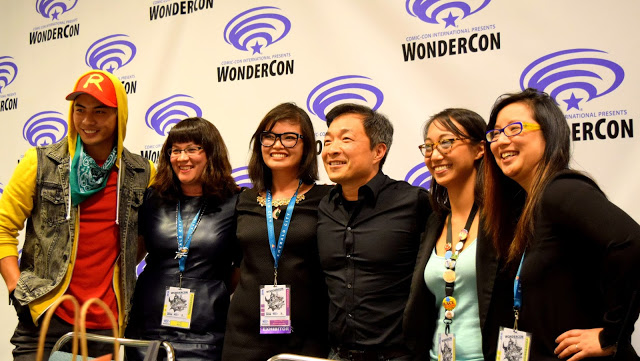 |
| The panel members of The Asian American Superhero |
The Comicbooks of Artist Alley
The struggle between embracing our adolescence through simple, jovial ideas against fulfilling our desire for more adult themed comicbooks was in full force as we navigated through artist alley and the small press section of the WonderCon exhibition floor. No single moment from our WonderCon experience better exemplifies this conflict than what occurred after stopping by Robert Goodin’s table to pick up a copy of the recently DIY-style publication of The Spiritual Crisis of Carl Jung, a story which originally appeared in Fantagraphics’ MOME in 2010.
As fans of Jungian psychology in general, we could not pass up Goodin’s tale about the man who gave us the concepts of archetypes and synchronicity. The Spiritual Crisis of Carl Jung focuses on one moment of Jung’s life and succinctly captures his discovery of his own direct relationship with God as compared to his relationship with God brokered through the physical church.
Conveyed through exceptional artwork and layout that sets a psychedelic mood beyond reality, The Spiritual Crisis elegantly handles the foundations of Carl Jung’s stance on the role of religion in psychology, which would conflict severely with that of his mentor, Sigmund Freud. You may wonder how this has anything to do with our struggle between adolescent and adult themed books, but if you are looking for some kind of Jungian moment of synchronicity, that is what we’ll discuss here.
For whatever reason, if not simply the moments of “coincidence,” Goodin’s table was next to that of Dan Goodsell, who is the author of the deliriously enjoyable Mr. Toast. And, through whatever magic happens through Facebook news feed presentation algorithms, the day after we spoke with Goodin, he drew and posted a picture of Sally Bear from his excellent children’s book The Kurdles with Mr. Toast, and we saw this as we were getting ready for the day, confirming that we would undoubtedly have to get more Mr. Toast in our lives.
Given Robert Goodin’s cartoon seen above, we immediately assumed that Mr. Toast was somehow related to the epically evil food items found in Evan Dorkin’s Milk and Cheese, but immediately, Mr. Goodsell convinced us otherwise.
No, the whimsical food products of Mr. Toast, Shaky Bacon, and Joe the Egg are less concerned with the drunken depravity that embodies Dorkin’s creation and instead guide kids through adult situations with no humor lost sans the bawdiness. We picked up three issues of Mr. Toast, our favorite being Mr. Toast Comics Number Three: Shaky’s Vacation. This short, laugh-out-loud book follows the journey of Shaky Bacon after he receives news that he has won a trip for two to Mexico. The issue is chock full of all of the dilemmas one would face on what should be a free, entertaining vacation, but alas, Shaky takes a beating through all of it and cannot be happier to return home to his cactus and CRT.
Besides the light and always humorous narrative, we have to applaud Mr. Goodsell for keeping the issues at an anachronous, low price at $3 an issue that are similarly sized as your standard mainstream single issue comicbook but without any advertisements, making Mr. Toast truly accessible for kids and families.
Just a stone’s throw away from Goodin and Goodsell, at Ming Doyle’s table, we saw a trade of Ollie Masters, Ming Doyle, and Jordie Bellaire’s The Kitchen, which caught our attention through its 70s crime film aesthetic with a touch of Milo Manara.
Sadly, the appeal stops at the cover. Masters creates a 70s mob drama where the wives take over their husbands’ work when they all go to prison but completely fails to write the women as women. Upon reading the dialog and reviewing their character arcs, you become more and more aware that Masters is a man writing women, and thus The Kitchen has no more originality than the thousands of 70s crime and mob drama films, television, and comics that already exist because the women are almost completely replaceable by men.
For a more nuanced tale of 70s mob crime, just watch a repeat of The Friends of Eddie Coyle, and even after you see it for the 100th time, you’ll still walk away with fresher ideas than you will with a first reading of The Kitchen.
The Comicbooks of Small Press Area
On the opposite side of the exhibition floor, WonderCon had a healthily large small press area, where plenty of strong independent creations also existed outside of Artist Alley.
Early in our survey through the section, we found the table of Karate Petshop publishing, which featured Norm Harper and Matthew Foltz-Gray’s Rikki, an adaption of Rudyard Kipling’s short story “Rikki-Tikki-Tavi” from The Jungle Book.
Set in present day, Harper begins his version of the story in the burrow, where Rikki the mongoose lives with his fiance Magda, and he creates a Rikki that has serious doubts about his abilities as a snake-killer. Harper eventually takes his Rikki to the human home, where he must defend Teddy and his family against the venomous Nag and Nagaina. We so appreciated the incorporation of the other mongoose pack into the adaptation along with the development of Rikki’s other domesticated animal friends, but the issue of this (and any) adaptation of Kipling then becomes the handling of the imperialistic aspects of the original Kipling story, which Harper side steps in a way that loses the caste system connotations of Rikki’s place in his world in favor of a more falsely humanistic approach where man and wild animals can co-exist harmoniously to create a better environment.
But, based on the human actions in the book, the responsibility would be placed on the backs of the animals as the humans sit by. The illustration by Matthew Foltz-Gray is quite good and works for this version of the story, which despite being flawed in terms of addressing issues of class does at least attempt to nuance the story in a way that is notably different from the original.
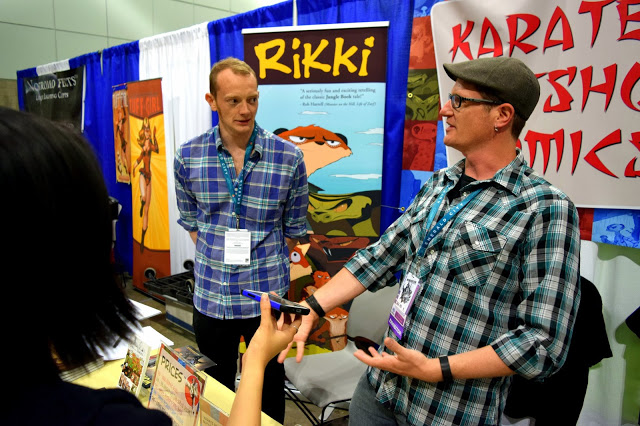 |
| Matthew Foltz-Gray and Norm Harper of Rikki |
Exemplifying the purest version of small, independent press represented at WonderCon is the inaugural issue of the Toi Soldier Project series The Tale Before Time.
Written by Heralcio Aguilar, a veteran of the War in Iraq, and illustrated by Louis Pieper, the first issue of The Tale Before Time introduces us to Kiefer, a veteran who is exploring his memories and understanding his full identity in addition to his recollections as a soldier. Though the series is only at its infancy, it handles the psychological exploration of trauma from war and family life in a frank, completely unpretentious way, which guarantees that readers from multiple perspectives can learn from Kiefer’s own comprehension of PTSD without any sensationalism. Whereas comicbooks and films have explored the veteran experience with the inclusion of plenty of action scenes or with talking heads reading semi-poetic text written clearly by someone who has not experienced war, The Tale Before Time does neither of these, setting a solid foundation for a perceptive and engaging story in issues to come.
Late during our tour of the small press section of the exhibition floor, we found Josh Shalek’s Falling Rock National Park. Lily is always lured in by anything set in the American southwest (it’s probably because of the obsession with Westerns), so when Shalek explained that he gained inspiration for Falling Rock from Arizona, where he grew up, we were immediately hooked. The series presents different characters who live or work in the national park, and while whimsical in a way not unlike Regular Show, which also includes a cast working in a park but a more city located one, each of the characters in Falling Rock National Park relates to another in a natural, human way. What ultimately makes Falling Rock stand out is its fun, playful visual style with characters so lively that they nearly feel alive on each page.
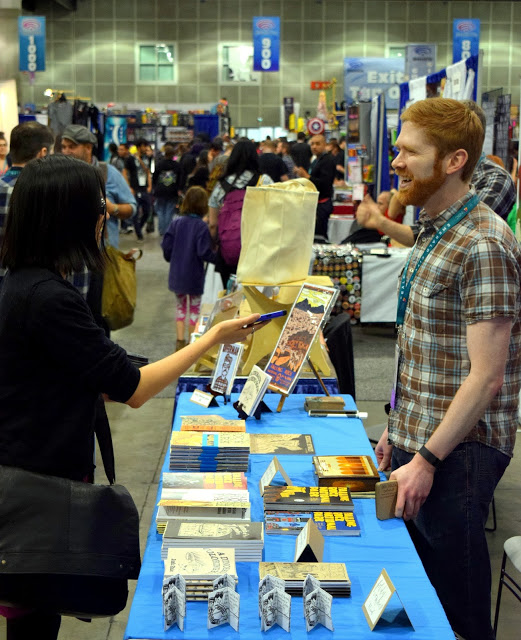 |
| Josh Shalek of Falling Rock National Park |
Our very first WonderCon gave us a small taste of what occurs at its parent comic-con in San Diego.
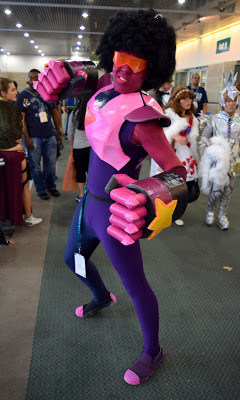 While the comics we found did not disappoint, WonderCon most definitely caters to a more pop culture oriented crowd and more specifically people interested in television.
While the comics we found did not disappoint, WonderCon most definitely caters to a more pop culture oriented crowd and more specifically people interested in television.
For comicbook fans, WonderCon certainly deserves a look, but you’ll need to spend more time filtering through the programming during your time at WonderCon.
For the pop culture generalist, WonderCon gives you an opportunity to get a sample tasting of solid works across different media forms.
What is strange about WonderCon is that despite the fact that the convention was held in LA, the home of creation for plenty of media, not a ton of entities that had the popularity of something such as Bob’s Burgers were present, which in a way, hurts the overall strength of the convention, leaving WonderCon feeling like the less glorious, somewhat neglected little brother in the comic-con family.
Like LA’s Mayor Garcetti, who visited the convention, we also hope that WonderCon will eventually return to Los Angeles (and with even more talent), but we’ll have to debate about whether or not we’ll make the trek over to Anaheim for three days in a row next year when it returns to its original location.




































































































